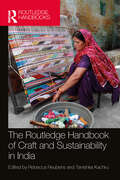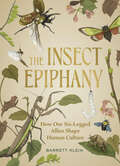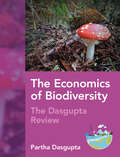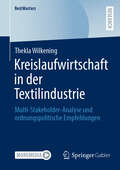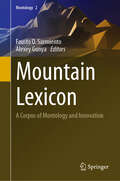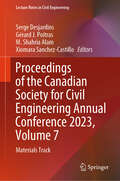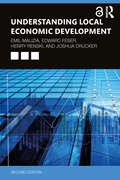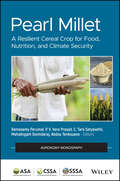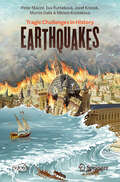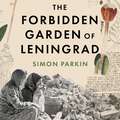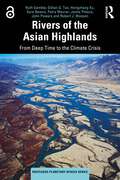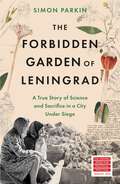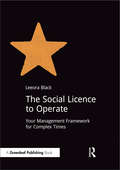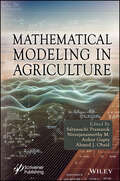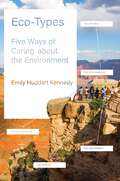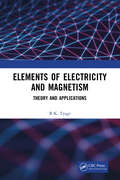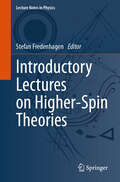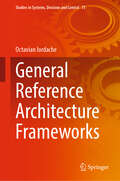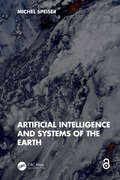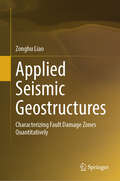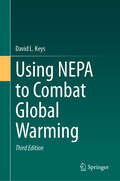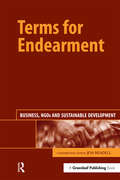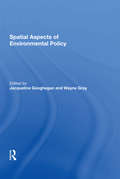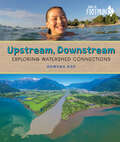- Table View
- List View
The Routledge Handbook of Craft and Sustainability in India
by Rebecca Reubens Tanishka KachruTraditional crafts have been an essential part of Indian history, culture and life. This handbook looks at craft as both a cultural artefact that reflects people’s worldviews, indigenous practices and traditions, as well as a source of income generation and development that is inclusive. India’s rapid development has meant a breakdown of traditional economies, and including craft production-to-consumption systems. Meanwhile, there is a call to action from different factions to protect, revive and reinvent craft, because the inherent sustainability of the systems that underpin it are essential for the sustainability of India and her people. Against this backdrop, this book examines the current landscape of craft in India—its production and marketing in different parts of India, the incorporation of innovation and technology, the push for sustainability and equitability in the handicraft ecosystem and promising government policies that have proved beneficial for craftspeople. It also discusses various challenges that artisans, micro-entrepreneurs, and marketers face working in the space. With contributions from leading experts in the field of design, activism, policy, education, cultural heritage and entrepreneurship, this volume provides a comprehensive and in-depth picture of the history, economics and future of craft and its relationship with sustainability.An authoritative resource on Indian craft, this handbook will be useful for scholars and researchers of sustainable development, development studies, architecture, design, heritage studies, cultural studies, political economy and public policy.
The Insect Epiphany: How Our Six-Legged Allies Shape Human Culture
by Barrett KleinFrom entomologist Barrett Klein comes a buzz-worthy exploration of the many ways insects have affected human society, history, and culture Insects surround us. They fuel life on Earth through their roles as pollinators, predators, and prey, but rarely do we consider the outsize influence they have had on our culture and civilization. Their anatomy and habits inform how we live, work, create art, and innovate. Featuring nearly 250 color images—from ancient etchings to avant-garde art, from bug-based meals to haute couture—The Insect Epiphany proves that our world would look very different without insects, not just because they are crucial to our ecosystems, but because they have shaped and inspired so many aspects of what makes us human.
The Economics of Biodiversity: The Dasgupta Review
by Partha DasguptaWe are part of Nature, not separate from it. We rely on Nature to provide us with food, water and shelter; regulate our climate and disease; maintain nutrient cycles and oxygen production; and provide us with spiritual fulfilment and opportunities for recreation and recuperation, which can enhance our health and well-being. Nature's constituents such as ecosystems and the biodiversity that are embodied in them are therefore assets. Yet Nature is more than an economic good: many recognise its intrinsic worth and argue that it has moral worth too. This landmark report explains the current state of play in relation to biodiversity loss and outlines a sustainable path to deal with this problem, one that will require us to change how we think, act and measure success. The report was originally commissioned and published by HM Treasury. This title is also available as Open Access on Cambridge Core.
Kreislaufwirtschaft in der Textilindustrie: Multi-Stakeholder-Analyse und ordnungspolitische Empfehlungen (BestMasters)
by Thekla WilkeningIn diesem Buch werden im Rahmen einer interviewbasierten Multistakeholder-Analyse die Perspektiven unterschiedlicher Stakeholder der textilen Kreislaufwirtschaft untersucht. Dabei wird analysiert, wie die Wertschöpfung aus dem Rohstoff Alttextil ökonomisch, sozial und ökologisch maximiert werden kann, um einen Beitrag zur Agenda 2030 zu leisten. Die derzeitige Erarbeitung einer nationalen Kreislaufstrategie zur Umsetzung der EU-Textilstrategie in nationales Recht ist ebenso relevant wie die verpflichtende, europaweite Getrenntsammlung von Textilien. In diesem Zusammenhang werden die Herausforderungen und Chancen einer kreislaufbasierten Textilindustrie bewertet und ordnungspolitische Maßnahmen wie eine Recyclingquote sowie ein digitaler Produktpass empfohlen. Kooperationen und Anreize, wie Steuervorteile oder freiwillige Kodizes für kreislauforientiertes Design, bieten zusätzliche Ansätze, um die Textilwirtschaft nachhaltiger zu gestalten. Resale und Recycling werden als zentrale Geschäftsmodelle hervorgehoben, deren Erfolg durch Zusammenarbeit, Digitalisierung und verbesserte Recyclingstrukturen gesichert werden kann. Ein gemeinsames Engagement von Bürger:innen, Unternehmen und der Politik ist der Schlüssel, um die Transformation zu einer nachhaltigen Textilindustrie voranzutreiben und eine umweltfreundlichere Zukunft zu gestalten.
Mountain Lexicon: A Corpus of Montology and Innovation (Montology #2)
by Fausto O. Sarmiento Alexey GunyaThis book is the second volume in a series on montology dedicated to the transdisciplinary reflection of mountain research, considering the diversity of views on mountains and their problemata in the context of rapid technological development and unprecedented accumulation and dissemination of information around the world. The necessity for a new orderly and structured lexicon arose from the need to critically reassess the colonial past in the development of mountain territories, the development of a new and alternative understanding of mountain topics in the light of decolonized epistemology. The creation of coordinated and ordered terms for the main parts of mountain research creates the basis for an unorthodox understanding of the ontology of mountains and helps to better understand the complex cultural and natural essence of mountain socio-ecological systems. At the same time, a local episteme of mountains, considering local values, small scales, and vernacular visions are of particular importance, which must be taken into account in the current terminology. The purpose of the book is to provide methodological support for montology as a convergent and transdisciplinary science of mountains, based on the harmonization of its terminological base. The book pays special attention to onomastics, toponymy, standardization and other nuances of terms used in mountain research. According to this goal, three dozen articles in a relatively small format (about 3 pages) vividly, attractively and innovatively reflect the modern view of one or more related terms. Articles include definition(s) of the term, description of etymology, onomastics or toponymy used, examples of local characteristics compared to traditional sources, possible vernacular terms. Articles are grouped into four main areas: 1) Basic glossary of montology terminology, 2) Towards mountain socio-ecological systems, 3) Innovative disciplinary systemic realm, 4) Mountain classifications, onomastics, critical toponomy and rediscovery of meaning. The authors of the articles are leading experts in the field of mountain research from around the world. The book is intended for scientists, experts and teachers. It is provided with an annotated list of the most important montology terms.
Proceedings of the Canadian Society for Civil Engineering Annual Conference 2023, Volume 7: Materials Track (Lecture Notes in Civil Engineering #501)
by M. Shahria Alam Serge Desjardins Gérard J. Poitras Xiomara Sanchez-CastilloThis book comprises the proceedings of the Annual Conference of the Canadian Society for Civil Engineering 2023. The contents of this volume focus on the specialty track in materials with topics on recycled materials, concrete durability, geopolymers, alkali-activated and other alternative binders, fiber-reinforced and engineered cementitious composites, advanced composite materials, ultra-high-performance materials, and innovative and emerging materials, among others. This volume will prove a valuable resource for researchers and professionals.
Understanding Local Economic Development: Second Edition
by Emil Malizia Henry Renski Edward J. Feser Joshua DruckerThis book offers insights into the process and the practice of local economic development. Bridging the gap between theory and practice it demonstrates the relevance of theory to inform local strategic planning in the context of widespread disparities in regional economic performance.The book summarizes the core theories of economic development, applies each of these to professional practice, and provides detailed commentary on them. This updated second edition includes more recent contributions - regional innovation, agglomeration and dynamic theories – and presents the major ideas that inform economic development strategic planning, particularly in the United States and Canada. The text offers theoretical insights that help explain why some regions thrive while others languish and why metropolitan economies often rise and fall over time. Without theory, economic developers can only do what is politically feasible. This text, however, provides them with a logical tool for thinking about development and establishing an independent basis from which to build the local consensus needed for evidence-based action undertaken in the public interest.Offering valuable perspectives on both the process and the practice of local and regional economic development, this book will be useful for both current and future economic developers to think more profoundly and confidently about their local economy.The Open Access version of this book, available at http://www.taylorfrancis.com, has been made available under a Creative Commons Attribution-Non Commercial-No Derivatives (CC-BY-NC-ND) 4.0 license.
Pearl Millet: A Resilient Cereal Crop for Food, Nutrition, and Climate Security (Agronomy Monographs)
by Mahalingam Govindaraj Abdou Tenkouano C. Tara Satyavathi Ramasamy Perumal P. V. Vara PrasadIn this age of climate change, discover how pearl millet is considered a viable alternative cereal crop for semi-arid and hot areas Pearl millet, a warm-season, dryland cereal crop, is a staple food for over 90 million people in Africa and Asia. Its nutritional superiority relative to other cereal crops, such as rice, wheat, maize, and sorghum, and its hardiness and adaptability to harsh environments and poor soils make it a potentially life-saving resource for poor populations and/or areas hit by damaging climatic conditions. With climate change Placing an ever-greater strain on global agrifood systems, pearl millet has never been a more important crop in the fight against poverty, hunger, and malnutrition. Pearl Millet offers a thorough introduction to this potentially vital grain. Coming on the heels of a 2023 United Nations declaration of the “International Year of Millets,” it is a crucial intervention in an essential humanitarian project. It is the first comprehensive book on the subject to appear in print. Key Features: Analysis of a potential lead crop for climate-change-affected areasDetailed coverage of all pearl millet’s unique features, such as inherent genetic diversity, gluten free applications, and suitability for double croppingAn author team with vast research and crop development experience Pearl Millet is ideal for advanced undergraduate and graduate students, certified and practicing professionals, as well as industry and academic researchers.
Earthquakes: Tragic Challenges in History (Springer Praxis Books)
by Peter Moczo Jozef Kristek Martin Galis Miriam Kristekova Eva RutšekováDiscover the profound, surprising, and instructive tales embedded within the tragic earthquakes and tsunamis of the years 1755, 1906, 1960, 1985, 2004, 2011, and 2023. Uncover the impact these events have had on our understanding of the planet we call home and explore how they shaped the destinies of entire nations.In this book, you’ll delve into the intriguing connection between seismic events and human missions to the Moon and Mars; pondering the warnings they carry for our future. As seismic risks on Earth escalate and humanity extends its reach into space, these challenges become pivotal for both current and future seismologists.Lastly, this book will allow you to embark on a riveting journey through the seismic tapestry of our past, present, and the uncharted territories of our future.
The Forbidden Garden of Leningrad: A True Story of Science and Sacrifice in a City under Siege
by Simon ParkinFrom the winner of the 2023 Wingate Literary Prize comes a fascinating and moving untold story of the Leningrad scientists who risked everything for the future of humanity"An astonishing story brilliantly told... It is as moving as it is gripping to read"Jonathan Dimbleby, author of Endgame: 1944"A gripping, original and important story of courage and science in wartime" Roland Philipps, author of A Spy Named OrphanIn the summer of 1941, German troops surrounded the Russian city of Leningrad - now St Petersburg - and began the longest blockade in recorded history. By the most conservative estimates, the siege would claim the lives of three-quarters of a million people. Most died of starvation.At the centre of the embattled city stood a converted palace that housed the greatest living plant library ever amassed - the world's first seed bank. After attempts to evacuate the collection failed, and as supplies dwindled, the scientists responsible faced a terrible decision: should they distribute the specimens to the starving population, or preserve them in the hope that they held the key to ending global famine?Drawing on previously unseen sources, The Forbidden Garden tells the remarkable and moving story of the botanists who remained at the Plant Institute during the darkest days of the siege, risking their lives in the name of science."A beautifully-written account of one of the most extraordinary and little-known episodes of the Second World War -- a scientific feat and act of collective self-sacrifice the consequences of which continue to be felt today."Adam Higginbotham, author of Challenger
Rivers of the Asian Highlands: From Deep Time to the Climate Crisis (Routledge Planetary Spaces Series)
by John Powers Jamie Pittock Gillian G. Tan Ruth Gamble Robert J. Wasson Hongzhang Xu Sara Beavis Petra MaurerRivers of the Asian Highlands introduces readers to the intersecting headwaters of Asia’s eight largest rivers, focusing on the upper reaches of two river systems: the Brahmaputra’s highland tributaries in the eastern Himalayan Mountains and the Dri Chu (upper Yangzi), which descends from the Tibetan Plateau’s east through the Hengduan Mountains.This book guides its readers through these two rivers’ physical, environmental, cultural, social, and political histories before providing a multifaceted assessment of their present. It uses general and detailed insights from multiple disciplines, including anthropology, conservation, geography, geomorphology, climate science, ecology, history, hydrology, and religious studies. The rivers’ stories explain how the catchments’ hazards—earthquakes, landslides, floods, droughts, and erosion—interact with their energetic, hydrological, ecological, cultural, and social abundance.This book’s multiple cultural and disciplinary perspectives on the rivers will interest anyone who wants to understand the rivers of this critically important region as the environment faces climate change and other ecological crises.
The Forbidden Garden of Leningrad: A True Story of Science and Sacrifice in a City under Siege
by Simon ParkinFrom the winner of the 2023 Wingate Literary Prize comes a fascinating and moving untold story of the Leningrad scientists who risked everything for the future of humanity"An astonishing story brilliantly told... It is as moving as it is gripping to read"Jonathan Dimbleby, author of Endgame: 1944"A gripping, original and important story of courage and science in wartime" Roland Philipps, author of A Spy Named OrphanIn the summer of 1941, German troops surrounded the Russian city of Leningrad - now St Petersburg - and began the longest blockade in recorded history. By the most conservative estimates, the siege would claim the lives of three-quarters of a million people. Most died of starvation.At the centre of the embattled city stood a converted palace that housed the greatest living plant library ever amassed - the world's first seed bank. After attempts to evacuate the collection failed, and as supplies dwindled, the scientists responsible faced a terrible decision: should they distribute the specimens to the starving population, or preserve them in the hope that they held the key to ending global famine?Drawing on previously unseen sources, The Forbidden Garden tells the remarkable and moving story of the botanists who remained at the Plant Institute during the darkest days of the siege, risking their lives in the name of science."A beautifully-written account of one of the most extraordinary and little-known episodes of the Second World War -- a scientific feat and act of collective self-sacrifice the consequences of which continue to be felt today."Adam Higginbotham, author of Challenger
Industry Genius: Inventions and People Protecting the Climate and Fragile Ozone Layer
by Stephen Andersen Durwood ZaelkeThis book presents the inventive genius behind technological breakthroughs by ten global companies including Alcoa, DaimlerChrysler, Honda, ST Micro and Visteon. Readers will gain understanding and insight into how cutting-edge technology is helping protect the climate and/or the ozone layer, while contributing to the company's bottom line. Each chapter chronicles the challenge and triumph of invention, introduces the engineers and executives who overcome conventional wisdom, and demonstrates the contribution these companies are making to environmental protection. In full colour and crammed with graphics to illustrate the creative process of technological breakthroughs, the book is accessible and informative. The genius of these ten companies will inspire the engineer, the policy-maker, the student, the environmentalist, the CEO and the investor alike.
The Social Licence to Operate: Your Management Framework for Complex Times (DoShorts)
by Leeora BlackThe "social licence to operate" began as a metaphor to bring attention to the need for companies to earn acceptance from their host communities. Today, it is a necessary management framework for complex times.A social licence strategy is essentially a stakeholder engagement strategy for navigating complex socio-political environments. This book provides the framework, tools and case studies a company needs to create a foundation for truly sustainable community development.This 90-minute guide will enable you to: define the social licence to operate; make the business case for actively managing your social licence to operate; measure the social licence to operate; develop a step-by-step plan to restore, build, maintain and enhance your company’s social licence; and report on your social licence.This book is for managers in any company facing rising social scrutiny due to unwanted social or environmental impacts. You may be working in natural resources, renewable energy, oil and gas, forestry, construction, manufacturing, retail, food processing, pharmaceuticals or any industry that is facing rising stakeholder expectations and increasing criticism.
Mathematical Modeling in Agriculture
by Ankur Gupta Ahmed J. Obaid Sabyasachi Pramanik Niranjanamurthy M.The main goal of the book is to explore the idea behind data modeling in smart agriculture using information and communication technologies and tools to make agricultural practices more functional, fruitful and profitable. The research in the book looks at the likelihood and level of use of implemented technological components with regard to the adoption of different precision agricultural technologies. To identify the variables affecting farmers’ choices to embrace more precise technology, zero-inflated Poisson and negative binomial count data regression models were utilized. Outcomes from the count data analysis of a random sample of various farm operators show that various aspects, including farm dimension, farmer demographics, soil texture, urban impacts, farmer position of liabilities, and position of the farm in a state, were significantly associated with the approval severity and likelihood of precision farming technologies. Farm management information systems (FMIS) have constantly advanced in complexity as they have incorporated new technology, the most recent of which is the internet. However, few FMIS have fully tapped into the internet’s possibilities, and the newly developing idea of precision agriculture receives little or no support in the FMIS that are now being sold. FMIS for precision agriculture must meet a few more criteria beyond those of regular FMIS, which increases the technological complexity of these systems’ deployment in a number of ways. In order to construct an FMIS that meet these extra needs, the authors here evaluated various cutting-edge web-based methods. The goal was to determine the requirements that precision agriculture placed on FMIS.
Eco-Types: Five Ways of Caring about the Environment
by Emily Huddart KennedyWhy acknowledging diverse eco-social relationships can help us overcome the political polarization that undermines our ability to protect the environmentWhen we picture the ideal environmentalist, we likely have in mind someone who dedicates herself to reducing her own environmental footprint through individual choices about consumption—driving a fuel-efficient car, for example, or eating less meat, or refusing plastic straws. This is a benchmark that many aspire to—and many others reject. In Eco-Types, Emily Huddart Kennedy shows that there is more than one way to care about the environment, outlining a spectrum of eco-social relationships that range from engagement to indifference.Drawing on three years of interviews and research, Kennedy describes five archetypal relationships with the environment: the Eco-Engaged, often politically liberal, who have an acute level of concern about the environment, a moral commitment to protect it, and the conviction that an individual can make a difference; the Self-Effacing, who share the Eco-Engaged’s concerns but not the belief in their own efficacy; the Optimists, often politically conservative, who are confident in their relationship with the environment, doubt the severity of environmental problems, and resent insinuations that they don’t care; the Fatalists, who are pessimistic about environmental decline and feel little responsibility to adopt environment-friendly habits; and the Indifferent, who have no affinity for any part of the environmental movement.Kennedy argues that when liberals feel they have a moral monopoly on environmental issues, polarization results. If we are serious about protecting the planet, we must acknowledge that we don’t all need to care about the environment in the same way.
Elements of Electricity and Magnetism: Theory and Applications
by R.K. TyagiThis book covers the theory, concepts, and applications associated with electricity and magnetism. It discusses various fundamental aspects including Coulomb’s Law, electric potential, capacitors, dielectrics, and paramagnetism. Aimed at undergraduate students with an elementary knowledge of mathematical analysis, it also includes solved problems at the end of each chapter for better understanding.The subject matter of this book also includes: The Biot-Savart Law RL Circuit Electromagnetic Wave Equation Displacement Current Equipotential Surfaces Print edition not for sale in South Asia (India, Sri Lanka, Nepal, Bangladesh, Pakistan or Bhutan)
Introductory Lectures on Higher-Spin Theories (Lecture Notes in Physics #1028)
by Stefan FredenhagenThe book offers a pedagogical introduction to higher-spin gauge theories. These theories build upon fundamental gauge theories that are crucial for understanding core interactions. Electromagnetism and nuclear forces are associated with gauge fields of spin 1, while gravity can be conceptualized as a gauge theory of spin 2. This prompts the intriguing inquiry: do higher-spin gauge theories exist? Such theories would extend gravity, incorporating massless gauge fields of spins higher than two. They appear to bear connections to string theory and offer a captivating framework for exploring gravity and aspects of quantum gravity. The book initiates with a primer offering a comprehensive discussion on higher spins, delving into the challenges of establishing coherent interactions. It then explores methodologies to surmount these challenges within three-dimensional space-time. Furthermore, it investigates the emergence of asymptotic symmetry algebras, establishing links to a holographic dual conformal theory. The final chapter introduces Vasiliev’s approach to higher-spin gauge theory in four dimensions. Designed for advanced students and young researchers in theoretical physics and mathematical physics, the book aims to elucidate fundamental ideas, concepts, and tools underpinning higher-spin gauge theories. The inclusion of numerous exercises complements and illustrates the content, preparing readers for engagement with the subject's original literature and ongoing developments. To fully engage with the book's arguments, a prerequisite understanding of field theories and conventional gauge theories, including gravity, is assumed.
General Reference Architecture Frameworks (Studies in Systems, Decision and Control #73)
by Octavian IordacheStudying high complexity projects implementation is the object of this book. Multiple interactions and emergences are the core of higher complexity and of associated models and projects. The starting point of our approach is the observed similarity or isomorphism of roadmaps toward higher complexity and of reference architectures for different domains of reality. The objective is to propose a General Polytopic Roadmaps (GPTR) and a General Reference Architecture Framework (GRAF) and use these for 8D Program implementation. The GPTR shows the stages: 0D, 1D, 2D, 4D, and 8D. The book is divided into 8 chapters. Chapter 1 introduces the GRAF as a 4D of 4D polytope. Chapter 2 emphasizes the role for the dialogue of processes in duality, of the logic of contradiction, of iteration and of included middle to face high complexity. Chapter 3 refers to operations and equipments of engineering interest as permutations, mixings and separations. Chapter 4 refers to modeling and simulation. Chapter 5 concerns creative design models. Dual process design, and processes integration are presented. Industry 4.0, future developments to Industry 8.0 and chemical engineering paradigms are evaluated in Chapter 6. Chapter 7 focuses on complex systems as production systems of systems architecture frameworks, decision models, operations processes, and cyber-physical social systems. Chapter 8 discusses implementation of high complexity projects for different levels of reality. The book is useful to engineers, researchers, entrepreneurs, and students in different branches of production, science, and engineering of high complexity.
Artificial Intelligence and Systems of the Earth
by Michel SpeiserArtificial Intelligence and Systems of the Earth is a book about the potential and capabilities of artificial intelligence (AI) and machine learning (ML) for studying the Earth. It aims to serve as an eye-opener on new avenues of scientific research that can be enabled by AI/ML. This is not meant to be a ‘how to’ book but is written to answer the question ‘what if’. It explains how these tools are currently being applied, and the new opportunities they have opened. Through many examples and application ideas from outside the Earth Sciences, the book discusses some of the most prevalent types of AI in current use, the future of AI hardware, and how AI/ML bring about change.Features Provides accessible and compact coverage on the many uses AI in Earth Science. Covers AI, deep learning, and causal modeling concepts in an easy-to-understand language. Contains a chapter on generat ive AI and its specific strengths and challenges. Includes descriptions of computer hardware for AI and where it is headed. Offers a companion website with regularly updated content. This book is an excellent resource for researchers, academics, graduate, and senior undergraduate students in Earth Science and Environmental Science and Engineering, who wish to learn how AI and ML can benefit them, its potential applications, and capabilities. The Open Access version of this book, available at http://www.taylorfrancis.com, has been made available under a Creative Commons (CC-BY) 4.0 license.
Applied Seismic Geostructures: Characterizing Fault Damage Zones Quantitatively
by Zonghu LiaoThis book focuses on the characterization of fault damage zones and subsurface structure systems quantitatively for the first time. It provides a comprehensive case study of various types of fault damage zones, including normal, reverse, strike-slip, and composite zones. The book also explores fractures within fault damage zones and the effect of faulting on cap rock integrity. Through meticulous case studies and analyses from diverse geographical regions, this book elucidates the seismic characteristics and behaviors associated with fault damage zones. Readers will find particular interest in the methods and results presented in the book, as it offers a holistic and systematic approach to understanding and building seismic geostructures. Incorporating seismic attributes and coherence analysis, as well as applying neural networks, it provides readers with innovative techniques in fault characterization and segmentation. Besides, this book incorporates illustrative visuals, insightful tables, and cutting-edge seismic attributes, which enhance the reader's understanding of the subject matter. Researchers, professionals, and students in petroleum geology, geophysics, and engineering will find this book to be an invaluable resource with the practical insights and innovative methodologies it offers for the state-of-the-art characterizing and analyzing fault damage zones.
Using NEPA to Combat Global Warming
by David L. KeysThis book will help policy makers, university students, and the general public understand how the National Environmental Policy Act (NEPA) is intended to work, and how it can be used to reduce greenhouse gas (GHG) emissions in order to combat global warming. Unlike all other books on NEPA, this book focuses on the global warming problem in terms of thermodynamics and entropy. It explains how NEPA can help combat global warming by operationalizing the “energy requirements and conservation potential” analysis requirement in the Council on Environmental Quality (CEQ) regulations, 40 CFR 1502.16 (a)(7), and it puts the past, present, and future of the NEPA statute, the CEQ regulations, and energy analysis requirements all in one easy to find, portable place. It will be an excellent resource for university students and teachers, policy analysts, and those members of the public that want to know all about the NEPA Process. As a third edition, the book contains new analysis on the amended NEPA statute (2023) and revised CEQ regulations (2024), CEQ’s January 9, 2023 interim guidance on how to incorporate GHG emissions into NEPA documents, the social costs of carbon, the long-term strategy of the United States to get to net-zero GHG by 2050, assessing climate risk in NEPA reviews, and the link between energy requirements analysis required by 40 CFR 1502.16 (a) (7) and reduced GHG emissions.
Terms for Endearment: Business, NGOs and Sustainable Development
by Jem BendellBusiness and NGOs are seen by many to be locked in a perpetual war of values and ideologies. What this book demonstrates is that the war has moved on. Many companies are now engaging with their stakeholders – even those with which they have traditionally had antagonistic relationships – as part of their strategies for improved social and environmental performance. With contributions from an outstanding and diverse group of experts from business, consultancy, research institutes, NGOs and academia, Terms for Endearment investigates the how and why of these new collaborations and provides concrete examples of business working with stakeholder pressure for sustainable development. The book forcibly argues the notion of organizations of civil society setting the standards for business behaviour in the 21st century. For those companies that choose not to pursue high standards of social and environmental performance, confrontation with NGOs must be expected, with negative consequences for sales, costs and social capital, i.e. the bottom line. Terms for Endearment therefore presents business with both a threat and opportunity as we move closer to establishing a social basis for global economic activity.
Spatial Aspects of Environmental Policy
by Wayne GrayThere has been a recent explosion of research incorporating a spatial dimension in environmental and natural resource economics, where the spatial aspects of human behaviour or the natural environment make a crucial difference in the analysis and policy response to the problem. Much of this research has been driven by the growing availability of spatially explicit social science data and the development of tools and methodological advances to use these data. Collected in this volume are 24 key articles considering the reasons for spatial variation in policies, due to either efficiency or equity considerations, and the consequences of that spatial variation for both environmental and economic outcomes. These articles demonstrate that the failure to address spatial issues in the analysis can create two problems: (1) the analysis provides a poor basis for predicting actual behaviour that is specifically based upon spatial considerations, and (2) the analysis fails to provide a basis for designing spatially targeted policies that could lead to more efficient outcomes.
Upstream, Downstream: Exploring Watershed Connections (Orca Footprints #21)
by Rowena RaeDo you know your watershed address? We all have one, whether we live high up in a mountain, on an inland prairie or near the coast. A watershed is an area of land that channels rain and snowmelt into streams, rivers and oceans. Our lives are deeply intertwined with land and water and all the connections between them. Day-to-day activities—like brushing our teeth, eating a meal, getting a ride in a car or even using an electronic device—have consequences for our own or someone else's watershed. Over the centuries we've changed the land by farming it, cutting down the trees on it, digging into it and building on it. We've also learned how to control water—where it goes and how much flows. Upstream, Downstream explores the consequences of the pressures people place on watersheds and highlights some of the heroes making a difference for watersheds around world. The epub edition of this title is fully accessible.
